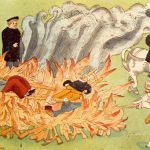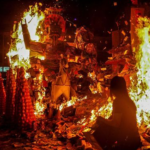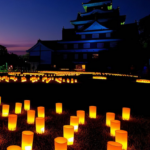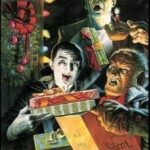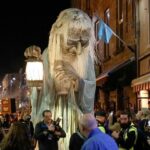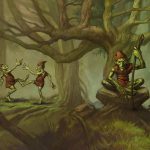Samhain was a harvest festival, marking the final harvest of the year and the beginning of the onset of winter. It was traditionally seen as an occasion for revelry as well as for making offerings to protect the cattle and crops over the coming winter.
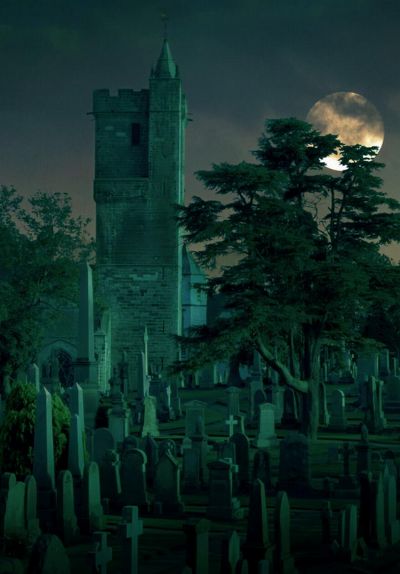
Fire would also play an important role in any Samhain ritual. Sometimes, two bonfires would be built side by side and the people, sometimes with their cattle, would walk between them as a cleansing ritual. In parts of Scotland, torches of burning fir or turf were also carried around homes and fields to protect them.
In some places, people doused their hearth fires on Samhain night. Each family then solemnly re-lit its hearth from the communal bonfire, bonding the families of the village together.
Whilst bonfires to scare away the undead are still lit in some areas of Scotland, more usually “neep lanterns” (turnip lanterns) are made by scooping out a turnip and cutting through the skin to create eyes, nose and mouth. A candle is then placed inside to make the lantern. These lanterns are also supposed to ward off evil spirits. Nowadays thanks to the influence of American culture, pumpkins are as common as turnips for lanterns.
Robert Burns, Scotland’s greatest bard, wrote extensively of how ancient beliefs had survived well into the Christian era, as he twisted stories of witchcraft and the devil with the traditions kept alive during Hallowe’en. His 1785 poem ‘Hallowe’en’ details many of the national customs and legends surrounding the festival which persisted even with the introduction of Christianity. From the second verse:
Some merry, friendly, country-folks
Together did convene,
To burn their nits, an’ pou their stocks,
An’ haud their Hallowe’en
Fu’ blythe that night…..(Translation: Some merry, friendly, country people
Together did convene,
To burn their nuts, and pull their plants,
And keep their Halloween
Full blythe that night.)
As mentioned in the lines above, a common Halloween tradition was for an engaged couple to each put a nut on the fire. If the nuts burned quietly then the marriage would be happy, however if the nuts spat and hissed then the marriage would be stormy. Similarly, if a girl put two nuts on the fire, one for her lover and one for herself, and the nuts spat and hissed, then this was a bad omen for their future together.
The plants mentioned in the poem above were the stalks of the kale plant or ‘castocks’. The stalks were pulled out of the ground after dark with one’s eyes shut. The idea was that the length and straightness of the stalk would indicate a future partner’s height and figure. Any soil on the stalk would indicate wealth.
In many parts of Scotland, it was customary to leave an empty chair and a plate of food out for invisible guests. People believed that it was the night when the souls of their dead ancestors were set free to roam and they might come into their houses and eat at their tables. The night was also known as ‘mischief night’, due to the tradition of playing pranks – something that has been recorded as far back as the 1700’s.
Until recently, ‘trick or treat’ was unknown in Scotland. Instead children dressed up and pretended to be evil spirits and went ‘guising’ (or “galoshin”). The custom traces back to a time when it was thought that by disguising children in this way they would blend in with the spirits that were abroad that night. Children arriving at a house so ‘disguised’ would receive an offering to ward off evil. Today it is expected that the children, as well as dressing up, also perform a party trick – a song or a dance, or recite a poem, for example – before they are offered a treat which could be fruit, nuts or more commonly nowadays, money or sweets.
The Witchcraft Act of 1735 contained a clause preventing the consumption of pork and pastry comestibles on Halloween. The act was however repealed in the 1950s so it is now legal to also offer pork pies or sausage rolls to children as treats!
The Samhuinn Festival in Edinburgh is an annual event marking the Celtic New Year. Presented by the Beltane Society, the event features a spectacular procession of fire, music, dancing, theatre and fireworks and takes place along Edinburgh‘s famous Royal Mile.

